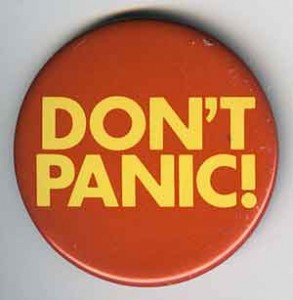(ThyBlackMan.com) Online Mindfulness Therapy helps Panic Attacks and Panic Anxiety…
Panic disorder affects between 3 and 6 million Americans, and is twice as common in women. We all experience panic at some time in our lives, but those suffering from panic disorder experience panic attacks on a daily basis, and this form of anxiety can severely reduce the quality of life, making even simple activities like grocery shopping unmanageable. In its most severe form this crippling form of anxiety can lead to agoraphobia, a very intense fear of going beyond the safety zone of one’s own home. In such severe cases, it is wise to seek medical help.
One of the characteristics of panic anxiety is the intense fear of the panic attack itself. Sufferers are deathly afraid of the next panic attack and the sense of losing control, and the social embarrassment that that will bring. Some times we feel afraid that the core anxiety is so powerful that it will  literally suck us in permanently into a state of madness. Most panic anxiety sufferers recognize that fear of fear is the main problem that they have to deal with and the main source of their emotional suffering.
literally suck us in permanently into a state of madness. Most panic anxiety sufferers recognize that fear of fear is the main problem that they have to deal with and the main source of their emotional suffering.
Panic anxiety is made up of primary reactions and beliefs that form the core of the emotion and a whole superstructure of secondary reactions, which are all the cognitive and emotional reactions of avoidance, resistance and proliferation. The cause of the primary reactions can be due to chemical imbalance or a severe emotional trauma that produces changes in the brain that result in a very primitive “fight or flight” type reflex reaction. Whatever the cause of the primary reaction, the mind is left with the job of trying to process this intense emotional energy, which leads to layer upon layer of secondary reactivity. The mind begins to proliferate beliefs about what is safe and what is a threat, resulting in avoidance behaviours, which can become very complex and convoluted.
The fear of losing control proliferates into endless worrying and catastrophic thinking, which intensifies and prolongs the original anxiety. This can lead to tertiary reactivity, which are all the feelings of depression and anger directed at oneself for not being able to cope and which lead to a loss of self-esteem and self-confidence.
Besides causing so much suffering, all these forms of secondary and tertiary reactivity have another harmful effect in that they prevent the core primary reactions from healing. The fear of the fear is like throwing salt onto an open wound, stopping it from healing, or throwing wood onto a bonfire, keeping the flames alight. The action of reactivity actually causes the primary fear to become rigid. In Buddhist Mindfulness Psychology, we say that the core anxiety loses its emotional plasticity. It becomes hard like ice, unable to change, unable to resolve itself, unable to heal. The main reason for this inhibitory effect is that worrying about our panic attacks has the effect of distracting our conscious awareness away from the core emotions and we become dissociated from them.
One of the most fundamental insights of mindfulness psychology is that conscious awareness is essential for any emotion to heal itself. Without that direct conscious awareness, suffering can never heal and will remain frozen in place, and will remain there indefinitely until we are able to bring consciousness back to the emotion. The common saying amongst mindfulness-based therapists is, “reactivity inhibits healing; mindfulness promotes healing,” and this is certainly the case for panic anxiety.
So how can we change the patterns of reactive thinking that keeps the whole process locked in place? Mindfulness Therapy offers a number of practical insights and solutions, but one of the most effective approaches is to change the way we respond to our fears and anxieties. When we are in the grip of anxiety, we don’t respond to our negative emotions at all; we react to them with some form of resistance, aversion or avoidance. This, of course, simply makes things a lot worse for the reasons described above. The art of responding, instead of reacting, is learning how to recognize the emotion as it arises and then respond to it purposefully, on our terms, rather than becoming a hapless victim, which is what happens when we become reactive.
When I work with panic sufferers, I encourage them to actively greet the emotion as it arises, with:
“Welcome. I see you. Please take your place, and I will take mine, and we will sit together for a while.”
This may seem strange, since we don’t normally feel welcoming towards our anxiety and fear and all those negative feelings and thoughts, but the effect can be very dramatic when we really get into the feeling of welcoming the emotions instead of resisting them, ignoring them or running away. For starters, you will begin to regain your power and position when you actually welcome the emotion. You become the host instead of the frightened victim. With practice, aided with some inner visualization and guided imagery, most people find that they can really develop this art of “being the host” and are amazed at the transformation that results. The intensity of the fear begins to loosen as they develop and cultivate this inner relationship with their emotions. In Mindfulness Therapy, we talk about establishing the “fertile ground” of the mindful-relationship with emotions. This inner space of non-reactive conscious awareness allows the emotions to regain their plasticity. They start to melt, just as ice melts in the warmth of sunlight. Mindfulness is like the warm healing rays of the sun, and it melts the frozen emotions that have been abandoned through reactivity into the deep recesses of the mind.
Eventually, we get down to the primary reaction itself and can learn to sit with the primary fear that powers the whole process. With sustained mindfulness, this dark and frightening ice monster cannot resist the healing power of mindfulness, and over time it also become plastic and begins to resume its natural process of healing and resolution. We know from experience how reactivity inhibits this process of natural inner healing and we see for ourselves how mindfulness is the opposite of reactivity. It is only logical that mindfulness promotes healing. Therefore, cultivate mindfulness and watch the changes unfold.
Written By Peter Strong
Official website; http://www.mindfulnessmeditationtherapy.com/
















Leave a Reply